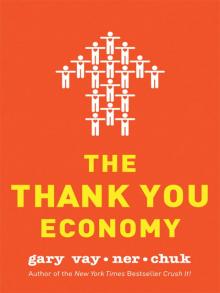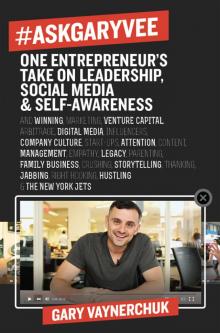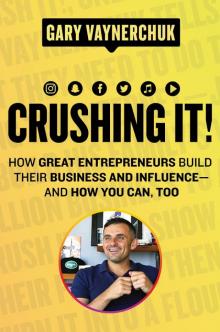- Home
- Gary Vaynerchuk
Jab, Jab, Jab, Right Hook Page 8
Jab, Jab, Jab, Right Hook Read online
Page 8
Showing off scrappy entrepreneurial spirit and making do with the resources you’ve got is admirable for a start-up, but not for a company like Land Rover, which sells a fairly expensive product.
STEVE NASH: A Disappointing Departure
It is entirely possible that this post was chosen for no other reason than that my dear friend Nate is a bitter Steve Nash hater for leaving his beloved Phoenix Suns, and I was only too happy to have an excuse to give Nash a negative review. That said, objectively speaking, this is one horrible piece of content.
Until now, Nash has cultivated a solid social media presence that respects the platforms and engages his fans. This piece is such a departure that it makes me wonder if he might have been surrounded by some strong social media advisers back in Phoenix, and then lost them when he moved to Los Angeles. The post was meant to promote the Steve Nash Foundation Showdown, a charity soccer match featuring NBA stars going against top futbol players from around the world.
Nonnative design: Anyone who visited Nash’s fan page directly was invited to the Steve Nash Foundation “HOWDOW.” If they consumed this on their phone they saw it as an “OWDOW.” You’ve got to be smart about your status update art, and someone on Nash’s media team was not.
Broken link: The URL attached to the update doesn’t link out, which means Nash is counting on fans cutting and pasting the link into their URL if they want to go to the Showdown website. I assure you all of zero people did that, which is too bad because it’s a beautiful website, not to mention an extremely cool and worthy cause.
No spam control: Finally, here we go again with the spam. The comment thread is littered with it. There’s a plague of people who use popular fan pages to promote themselves or their businesses, and the managers of these pages need to do a better job of weeding them out.
All of these mistakes can only be a result of carelessness or laziness. Nash fans deserve better.
AMTRAK: Using Sawdust to Its Advantage
I ride Amtrak all the time, and this Facebook post made me glad that I do. I love this post—it’s one of the best jabs I’ve seen in a long time. Best of all, it allows me to dispel some confusion about what social media can and cannot do.
Great use of sawdust: You’ve got to be damn smart to figure out how to take an image of something quite boring, even forgettable, like two train seats, and turn it into a fun, energizing piece of content. I call material like those train seats “sawdust”—assets that you have just lying around, maybe something you totally take for granted.
Gamification: Not only did Amtrak take advantage of their sawdust, they gamified it. Tag who you’d like to travel with—that’s a fun, clever challenge that strikes an emotional punch (although it’s a fairly big ask that could give you unreliable results). And what a great way to take advantage of the platform. Every person who receives a notification that they’ve been tagged will immediately register the Amtrak brand. It’s a great way to build awareness even among people who may not already be fans.
Authenticity: There’s a real person behind this post, too. You can tell because when one fan suggested Justin Bieber as his preferred seatmate, Amtrak replied with “But where would Selena Gomez go?” With one sentence, Amtrak reveals that its employees are our contemporaries, people just like us, with their fingers on the pop culture pulse, a sense of humor, and a real interest in their customers.
The only criticism worth lobbing at Amtrak is that they chose a picture of some pretty worn-out seats. The last time these seats saw some fresh upholstery was probably in 1964, when they were probably made. This brings me to the misconception a lot of marketers have about social media. It’s not lipstick. No matter how brilliant, clever, or authentic you are, nothing will cover up the flaws in your content. Some people will appreciate the retro look of the seats, but a lot of people won’t find them very appealing. Amtrak would have been wise to choose some less worn-out seats, or cleaned these up a little better before posting a picture of them. This poor sense of aesthetic is the only detail marring what is otherwise a perfectly executed jab.
BLACKBERRY: Missed Details Matter
My team and I struggled for several minutes to understand the story behind this post. We liked a lot about it, but then we realized that if it was that challenging to figure out what BlackBerry was trying to say, the story couldn’t have registered much with an audience that probably spent less than a second thinking about it.
Poor storytelling technique: I understand the story that BlackBerry was trying to tell—the BlackBerry Z10 is two phones in one—one for work, one for play. And if you click on the link below the picture, you’re taken to a pretty cool YouTube video that illustrates exactly what’s special about the phone. In addition, you’ll find another link that takes you to the product’s retail site. But though the brand correctly chose to make its photo the star of the update, the image does not do enough of the storytelling for us. Why not show someone attending a kid’s soccer game juxtaposed with a shot of that same person at the office? You have to look extremely closely to recognize the difference between the two screens. In addition, the text talks about work-life harmony, but the screens are reversed, in life-work order. That’s sloppy. And finally, people live their whole lives looking at screens—now they have to look at screens on their screens? It’s a little meta for a mobile device company.
BlackBerry was right to make a big push for this product and tell their story in social, but they should have paid more attention to the details of their execution.
MICROSOFT: Riding the Waves
It’s nice to see a stodgy, unsexy company show its creative, fun side as it rides the zeitgeist.
Good use of links: In this exciting jab, Microsoft is promoting a product called Fresh Paint, an app that allows you to use a palette of colors to “paint” in templates or even on your own pictures and photographs. Fans can read all about it in the blog Microsoft posted two months before this status update, easily accessible via the link beneath the picture of Dory and Nemo. It tells us how Microsoft partnered with Disney-Pixar to create a Fresh Paint “Finding Nemo pack,” a collection of original coloring pages and their appropriate palette of colors. They wisely took advantage of the announcement that there would be a sequel to Finding Nemo to showcase their product.
Offers quality, value, and authenticity: The post shows that the creative team at Microsoft is doing some smart thinking about where the cultural conversation is going, and how they can find ways to be a part of it. The brand receives more high marks for the quality of the image, the fact that the voice of the text isn’t too corporate, and the way they brought something of value to their community. In this status update and on the blog, Microsoft really does sound excited about both the movie and their product. If only more companies would use Facebook this well.
ZEITGEIST: Missing Its Inner Hipster
This post is stunningly bad. Hipsters have told me that Zeitgeist is the ultimate hipster bar in San Francisco. Ironically, everything that’s wrong with this jab could have been easily avoided if someone with a modicum of stereotypically hipster skills had created the post.
Low Facebook value: First, the post in and of itself has zero value but to divert fans to Twitter. There’s no copy, just a mess of hashtags. Hashtags have infiltrated our culture so much that people are starting to use them as an ironic coda to status updates and even regular conversations. They have long been a huge part of Twitter and Instagram’s appeal, where they overindex, and recently Facebook introduced them to the platform as well. It’s possible that Zeitgeist was trying to incorporate hashtags into their voice, but they don’t work here.
Incorrect post format: Next, it’s a link post, and at the time this post was created, link posts underperformed compared with picture posts that link out (though that could change in the future). In this case, though, a picture post wouldn’t have saved the status update. It might have even made it worse.
Sorry photography: The link takes us to a Twitter acc
ount where we see that Zeitgeist tweeted out a picture of what must be a Russian River Brewing beer tasting, showing a group of people sitting around a flight of beers. But the picture is so dark and blurry you really have to work to see what it is. That defies reason. Zeitgeist is a hip brand whose demo is all about modern technology. Photography has become a kind of social currency. This is not a great photo. It’s not even good. It’s the kind of picture you delete and take again. By allowing this subpar art to get posted, Zeitgeist implies that it’s actually not very good at tech, and not as hip and cool as its customers. It’s the kind of subliminal message that can kill a company.
TARTINE BAKERY: One Hot Mess
Tartine Bakery, a hugely popular café and pastry shop in San Francisco, has published two gorgeous illustrated cookbooks that received national attention and praise. Their Facebook post, however, indicates that like many entrepreneurs, businesses, and Fortune 500 companies, they are willing to invest energy, effort, and dollars into familiar platforms, but they have yet to put that same creative and strategic energy into the contemporary platforms where their fans actually spend more of their time. This post has so much wrong with it I have to edit my comments for the sake of space.
Unclear messaging: This post on the Tartine Bakery fan page is actually promoting an event at the bakery’s sister restaurant, Bar Tartine. It’s fine to cross-promote among communities, but they should have made it explicitly clear that this isn’t a bakery event, since most fans are coming to this fan page looking for bakery news.
Awkward text: They write: “Bar Tartine (with Link!) hosts . . .” What an awkward, poorly written phrase. Plus, it shows that someone at Tartine actually believes that fans are too stupid to know what that little blue URL is for at the end of the post.
Irrelevant hashtag: What’s up with the hashtag? The post doesn’t direct us to Twitter, so what purpose does it serve here?
No photo: This is as visually unfriendly as it gets. Tartine is promoting a food-centered charitable event, and they couldn’t whet our appetites with a little teaser of food porn or some other cool image to get us excited about it?
The fourth error might explain mistake number three. Not only did Tartine not include an image to accompany its charitable event, but it looks like they actually deleted one. When you attach a URL to a status update, a thumbnail image automatically appears beneath your post. But there is none here. The only way that can happen is if someone chose not to include an image. If you type the URL into your browser and head over to the fund-raising event’s page, you might see why. There you’ll find the most god-awful picture of a deconstructed burger ever drawn. The lettuce is vaguely dinosaur-shaped and fluorescent green; the meat, which actually looks like strips of radicchio glued together, glows red from the inside like some kind of nuclear accident about to happen, topped with fluorescent green caterpillars that are probably supposed to be pickles. It is a nightmare. No wonder Tartine Bakery didn’t want that thing showing up on its fan page. Which then raises the question, why didn’t they step in and provide better art to the organization that created the fund-raising Web page?
Insufficient page management: Finally, back on the fan page, the four spam comments—the only comments anyone bothered to make—are the cherries on top of this crap sundae.
TWIX: Having Fun
Twix threw a good jab here. They left their logo off the photograph, which is too bad, because as I have repeatedly pointed out, these images go through consumers’ mobile streams so quickly it’s easy for them to see a picture but not register who posted it. That said, Twix is such an iconic candy bar that most people will probably recognize what they’re seeing right away, so in this case the omission isn’t that big a deal.
Clever storytelling, strong voice, good use of pop culture: In the past, Twix has run television ads that played on the crisp sound of a Twix snapping in two, and in this post they’re reinforcing that story by playing off the well-known “tree in the forest” philosophical riddle. It’s a cute idea. The text shows that the writer has a strong feel for the brand’s quirky, playful voice. The nice level of engagement the post received proves how appealing it is to customers when a brand skillfully inserts itself into the pop culture conversation to tell its story. They should be primed to respond whenever Twix gets ready to throw a right hook down the line.
COLGATE: Good Copy Gone Bad
Catchy text: “Did You Know?” in all caps works for me. Maybe I like the copy in this Colgate post because I grew up an ESPN SportsCenter fan. Regardless, this is an appropriately short, tight, positive reinforcement of the brand’s interest in being important to a community that values a healthy, wholesome lifestyle. Unfortunately, the excellent text is attached to a picture that screams stock photo. Its generic personality zaps away any brand reinforcement the company could have engendered with its strong setup. Interestingly, the post did receive some strong engagement. I credit the good copy. The brand could have seen even more response had it just overlaid the Colgate logo and the text directly onto the picture. That might have even gone viral. As it stands, though, this post is a yawn.
KIT KAT: Timed Out
This is as good as a status update gets, except for one teeny, tiny mistake that makes a huge difference in the reach and influence of any post.
Art, tone, logo, text—it’s all good: Posted the Friday before the 2013 Super Bowl Sunday, the art in Kit Kat’s status update is fun and creative, and with pitch-perfect tone the picture and art lend an entertaining voice to the global conversation. In the right-hand corner, they included their slogan, which is an excellent alternative to a company logo. More brands should use their slogan and consistently incorporate it into their social media efforts. The product is prominent and cleverly used; the text, the tagline, and the brand slogan echo each other; the cultural reference is universal. The only misstep is in the timing of the post.
Thoughtless timing: The Super Bowl in 2013 featured the Baltimore Ravens and the San Francisco 49ers. Kit Kat launched this post at 6 A.M. Eastern Standard Time. In general, a 6 A.M. post is going to underindex because it only hits the early risers. Now, there were probably plenty of Ravens fans checking Facebook as they muddled through their early-morning routines, so it surely wasn’t a complete loss. But what about the 49ers fans in San Francisco? It was 3 A.M. in their time zone when this post went live. Three o’clock in the morning has to be the single worst time you could post anything on social media. Even the people working two jobs to make ends meet are sleeping at 3 A.M. Hell, I’m sleeping at 3 A.M. (when my infant son lets me). No one on the West Coast was watching when Kit Kat posted this status update. This is a great example of how a brand’s poor understanding of the psychology and behaviors of social media users can weaken their best efforts. In this case, it’s a real shame, because Kit Kat’s performance is so strong in this arena, other companies should be modeling their jabs after it.
LUKE’S LOBSTER: Logoless
I love this place. Only my wife, Lizzie, knows how much—we once ate here four days in a row. On this post, Luke’s Lobster did a nice job on their copy. But since the company’s timeline is filled with pictures of lobster rolls pretty much 365 days a week, it would have been a nice twist to show some mother flair on their Mother’s Day post. That’s the missed opportunity.
The real problem, though, is that it would be easy for the speedy and casual observer to think that Cape Cod Potato Chips put out this post. Lots of brands post Facebook and Instagram shots that incorporate products from companies other than their own, and that’s fine—so long as you have prominently branded your photo with your company logo in a highly noticeable corner. Which you really should do. Every time.
DONORS CHOOSE: A Solid Try
Many nonprofits litter the social media universe with such spammy content they make the likes of Lil Wayne look good (see page 59). This piece of content doesn’t have the branding elements or many of the important details I’ve demanded from other businesses, but so few
nonprofits do anything on Facebook but throw right hooks asking for money or inviting people to fund-raising galas that I wanted to give some love to Donors Choose for throwing this jab. In fact, they generally post a lot of status updates that show they’re committed to jabs. I know nothing about this NGO or how it is run, but this quote seems thematically appropriate and tied to their mission. Sure, it’s generic, but who knows, maybe they’ll read this book and learn how to take their content up a notch. While they’re at it, they can put some additional effort into their community management, which is currently almost nonexistent. If there’s any place where people need to feel a strong sense of humanity, it’s from the nonprofit world.
INSTAGRAM: A Textbook Case, and Not in a Good Way
As you’d expect, Instagram’s Facebook page is filled with stunning visuals, and this one accompanying a list of Instagrammers exhibiting their work at the Venice Biennale is gorgeous. The announcement itself, though, shows that when Facebook bought Instagram, they didn’t give their new employees a tutorial on how to properly storytell on their own platform. How could a subsidiary of Facebook post such copy-heavy images? There’s not even a punch line or pitch. Instagram may as well have thrown up a textbook on their timeline for all the excitement that post inspires.
CONE PALACE: Yum
I need to thank Cone Palace for giving me a chance to offer an in-depth commentary at what spot-on micro-content strategy looks like. Cone Palace is an institution in Kokomo, Indiana. I can’t speak about the food from experience, but if its owners pay as much attention to the quality and taste of their food as they do to their Facebook marketing strategy, it’s no doubt a good reason why they’ve stayed in business since 1966.

 The Thank You Economy
The Thank You Economy Crush It!
Crush It! #AskGaryVee
#AskGaryVee Crushing It! EPB
Crushing It! EPB Jab, Jab, Jab, Right Hook
Jab, Jab, Jab, Right Hook